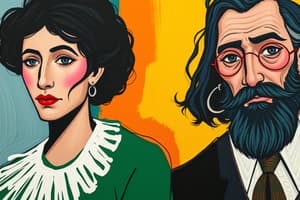Podcast
Questions and Answers
What is characterization in a short story?
What is characterization in a short story?
Creating and describing characters
According to Edgar Allan Poe, which of the following describes a formulaic structure of a plot?
According to Edgar Allan Poe, which of the following describes a formulaic structure of a plot?
- Suspenseful climax (correct)
- No climax
- Dramatic twist at the end (correct)
- Multiple protagonists
The primary emotion the reader feels towards the protagonist is ___
The primary emotion the reader feels towards the protagonist is ___
empathy
In literature, what is a protagonist?
In literature, what is a protagonist?
A static character undergoes significant development throughout the story.
A static character undergoes significant development throughout the story.
What is the setting in a story?
What is the setting in a story?
What defines the third-person omniscient point of view?
What defines the third-person omniscient point of view?
What is foreshadowing?
What is foreshadowing?
Who is the author of 'The Canterbury Tales'?
Who is the author of 'The Canterbury Tales'?
What must the knight discover in 'The Wife of Bath's Tales'?
What must the knight discover in 'The Wife of Bath's Tales'?
The journey to Canterbury featured ___ pilgrims.
The journey to Canterbury featured ___ pilgrims.
What does the code of chivalry represent?
What does the code of chivalry represent?
The knight’s tale culminates in a joyous ending without any conflict.
The knight’s tale culminates in a joyous ending without any conflict.
Flashcards are hidden until you start studying
Study Notes
Fiction and Characterization
- Short stories involve creating and describing characters with a clear structure: beginning, middle, and end.
- Key elements include a suspenseful climax and a dramatic twist at the end, as per Edgar Allan Poe's principles.
- Protagonist evokes reader empathy, whereas the antagonist opposes the main character.
- Character development can be dynamic (evolving characters) or static (unchanging).
Points of View
- First-person POV features a narrator who is also a character, using first-person pronouns.
- Third-person POV employs an external voice using third-person pronouns (he, she, it, they).
- Third-person omniscient POV reveals all character thoughts and actions.
- Third-person limited POV focuses on the thoughts and feelings of a single character.
Plot Techniques
- Exposition introduces characters, setting, and situation.
- Complication initiates conflict, escalating into a crisis filled with curiosity and tension.
- Climax represents the peak of the story; denouement resolves conflicts, leading to equilibrium.
Canterbury Tales
- A collection of diverse tales written by Geoffrey Chaucer, reflecting human nature and social observation.
- Pilgrimage begins at the Tabard Inn in Southwark, London, involving 30 pilgrims from varied backgrounds.
- Purpose of the pilgrimage is to visit the shrine of Saint Thomas in Canterbury.
- Stories entertain during the journey, with the best storyteller awarded a free meal.
Notable Tales
- The Wife of Bath's Tale: A knight must discover what women truly desire to avoid death; learns that women seek sovereignty.
- The Pardoner’s Tale: Three men’s greed leads them to kill each other while searching for gold, illustrating how greed causes downfall.
- The Knight’s Tale: Arcite and Palamon, two knights, fall in love with Emelye. Arcite wins her love but dies, urging Palamon to marry her.
- The Miller’s Tale: John is tricked by his wife and her lover while attempting to escape a false flood, leading to comedic chaos.
Medieval Period
- The Normans, led by William the Conqueror, defeated the Anglo-Saxons in the Battle of Hastings, marking significant historical change in England.
- Knights adhered to a code of chivalry characterized by honor, courtesy, bravery, and skillfulness.
Medieval Romances
- Featured imaginative incidents and stories that often reflected the ideals and values of medieval society.
Studying That Suits You
Use AI to generate personalized quizzes and flashcards to suit your learning preferences.




